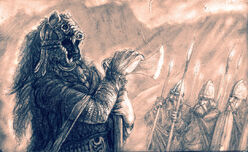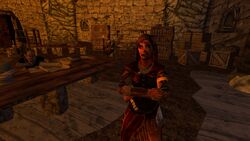HiddenVale (talk | contribs) (Making fixes and showing the interchangeableness of the two synonymous names) Tags: Visual edit apiedit |
mNo edit summary Tags: Visual edit apiedit |
||
| Line 1: | Line 1: | ||
[[File:Dunland_chief.jpg|thumb|248px|Dunlendings (by Merlkir of Deviantart)]] |
[[File:Dunland_chief.jpg|thumb|248px|Dunlendings (by Merlkir of Deviantart)]] |
||
| − | '''Dunlendings''', also known as '''Wildmen of Dunland,''' were the people of [[Dunland]]. They were known as a fierce culture of [[Men]] who sought vengeance on the people of [[Rohan]] who, as Saruman rightly said, drove them into the mountains. In [[The Two Towers (film)|The Two Towers]], Saruman used their anger as a manipulation and |
+ | '''Dunlendings''', also known as '''Wildmen of Dunland,''' were the people of [[Dunland]]. They were known as a fierce culture of [[Men]] who sought vengeance on the people of [[Rohan]] who, as Saruman rightly said, drove them into the mountains. In [[The Two Towers (film)|The Two Towers]], Saruman used their anger as a manipulation and convinced them to destroy the land of Rohan during the [[War of the Ring]]. He sends them across Rohan, burning and looting the land. |
Dunlending Wildmen come from the land of [[Dunland]]. When looting Rohan earlier in the Third Age, they are led by a Dunlending named [[Wulf I| Wulf]] son of Freca. |
Dunlending Wildmen come from the land of [[Dunland]]. When looting Rohan earlier in the Third Age, they are led by a Dunlending named [[Wulf I| Wulf]] son of Freca. |
||
Revision as of 17:35, 23 February 2017

Dunlendings (by Merlkir of Deviantart)
Dunlendings, also known as Wildmen of Dunland, were the people of Dunland. They were known as a fierce culture of Men who sought vengeance on the people of Rohan who, as Saruman rightly said, drove them into the mountains. In The Two Towers, Saruman used their anger as a manipulation and convinced them to destroy the land of Rohan during the War of the Ring. He sends them across Rohan, burning and looting the land.
Dunlending Wildmen come from the land of Dunland. When looting Rohan earlier in the Third Age, they are led by a Dunlending named Wulf son of Freca.
History

A Wildman swearing allegiance to Saruman
In the years of the Second Age before the Numenoreans settled in Middle-earth, tribal hill-men inhabited the lands west and south of the Misty Mountains, as far down as the valleys surrounding the White Mountains.
Wary of the men who came out of the west, they came to fear and hate them. They were hunted and persecuted in such numbers that they had dwindled by the start of the Third Age. At this time they had come to congregate in the valleys of the White Mountains and the grassy plains of Dunland, which lay west of the Misty Mountains between Moria and Isengard; a few went north, and became the ancestors of the Men of Bree. Dunland then became the area most populated by these men, who came to be called Dunlendings.

Dunlending spearmen in the Third Age
When Eorl and his people were granted Calenardhon --- Rohan, as it would later be known --- in TA 2510, they drove the Wild Men from their new lands, earning their bitter hatred and enmity. The Wild Men were also driven from the White Mountains by the Men of Gondor. During the next five hundred years these shorter, dark-haired warriors made frequent attacks upon the outlying settlements of Rohan, exacting revenge upon the usurpers, whom they called "straw-heads" because of the high number of blond warriors among them.
As a consequence, Rohan maintained patrols and garrisons to the west of the Fords of Isen to try to limit the number of raids, although these patrols had virtually disappeared under Wormtongue's stewardship, to the point where Saruman's forces could make incursions almost at will.
Yet not everybody took against the Wild Men. At some point near the end of the thirtieth century of the Third Age, Saruman made contact with them and swayed them to his side by playing on their resentment and hatred of those who had taken what was theirs.
Saruman welcomed to Orthanc a large warband of these Dunlendings. Saruman evidently convinced them that they could reclaim what had been taken, and during the early part of TA 3019, a fearsome raiding force comprising Dunlendings, Orcs and Uruk-hai left Isengard and began ravaging the western settlements of Rohan. Previous attacks by Orcs and Uruk-hai had killed many Rohirrim at the Fords of Isen, so there were no warriors to defend against the surprise attack.

Dunlendings in The Lord of the Rings Online
Many people of Rohan were killed in these attacks, but the raiders never made it across the country to Edoras; it is fair to assume that they encountered one or more Éoreds, companies of mounted warriors, who would have been patrolling the interior. After the defeat of Isengard at the Battle of the Hornburg, the Rohirrim spared the surviving Dunlendings and used them as workmen to repair the broken walls of the Hornburg.
The Rohirrim's mercy surprised the Dunlendings, as Saruman had convinced them the Rohirrim would slaughter them all if given the chance. When Gandalf, Frodo Baggins, Sam Gamgee, Merry Brandybuck, and Pippin Took were traveling through Dunland on their way back towards the the Shire, the Dunlendings in that area hid from them. After the War of the Ring, the Dunlendings sent ambassadors to the court of King Aragorn, thus finally began peace and diplomacy between Gondor and Rohan with the Dunlending realms.[citation needed]

A Dunlending chieftain by Merlkir (Deviantart).
Culture
The Dunlendings were hill-folk used to living in harsh conditions, often seen in leather garb and fur cloaks. They may have been related to the Snowmen of Forochel in the north. They were a tough, hardy people, big and powerful with long, unkempt hair and beards. The Dunlendings, because they lived in the hilly and forested area of Dunland, most likely hunted, foraged, and fished for food, with agriculture being a lesser form of food production.
The Dunlendings, due to their way of life, probably were very skilled with bows. Dunlendings are also described as using cavalry at the Fords of Isen. Most Dunlendings probably fought, however, on foot, with long spears, axes and other melee weapons (as with most self-arming forces, swords were expensive and therefore a rarity). Armour for most soldiers was light, but well-off warriors and chieftains likely made use of chainmail and were clad similarly as their Rohirrim counterparts.
Portrayal in adaptations
Wildmen of Dunland.
The Lord of the Rings: The Battle for Middle-earth II
They Dunlendings are used as units or powers which Isengard and the Goblins can use for 10 power points.
The Lord of the Rings Online
The Dunlendings appear as both enemies and allies in this game, and, like most hillmen in the game, are based loosely on Celtic tribes.
|
The People of Middle-earth
Men:
Edain | Dúnedain | Númenóreans | Haradrim | Easterlings | Variags | Northmen | Dunlendings | Drúedain | Forodwaith (Lossoth) Vanyar | Ñoldor | Teleri | Sindar | Nandor | Avari Durin's Folk | Firebeards | Broadbeams | Ironfists | Blacklocks | Stonefoots | Stiffbeards |
External links
Template:Space
